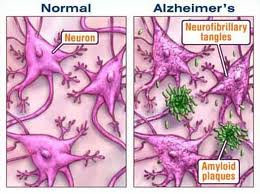Amyloid plaques in the brain may cause walking pace to slow down before causing signs of dementia.
Researchers at the Gerontopole and the Center of Excellence in Neurodegeneration of Toulouse, in France, hypothesized that a slower speed of walking may be related to the amount of amyloid plaque people with Alzheimer's have built up in their brains, even if they do not yet have external symptoms of Alzheimer's disease.
Scientists consider amyloid plaques the most likely cause of the damage that underlies Alzheimer's.
Amyloid precursor protein (APP) occurs throughout the body. The amyloid hypothesis proposes that there is a fault with the processing of APP in the brain, leading to the production of a short fragment of APP, a sticky protein known as beta-amyloid.
The accumulated clumps of beta-amyloid are known as amyloid plaques.
When this sticky protein fragment accumulates in the brain, it is thought to trigger the disruption and destruction of nerve cells that cause Alzheimer's disease.
Brain scans, motor and cognitive skills examined
The team looked at 128 people with an average age of 76 who did not have dementia but who were considered at high risk for developing it because they were experiencing problems with their memory.
Positron emission tomography (PET) scans were carried out on the participants' brains to measure for amyloid plaques.
Of the participants, 48% had a level of amyloid often associated with dementia.
The participants' thinking and memory skills and their ability to complete everyday activities were also tested. A total of 46% of the participants had mild cognitive impairment, which can signal the start of the dementia that occurs in Alzheimer's disease.
Walking speed was measured using a standard test that times people on how fast they can walk about 13 feet at their usual pace. The average walking speed was 3.48 feet per second. All but two of the participants were in the normal range of walking speed.
Association between walking speed and amyloid levels
The researchers found an association between slow walking speed and amyloid in several areas of the brain, including the putamen, a key region involved in motor function.
When they compared how fast people walked both with and without taking into account the amount of amyloid, the researchers found that the amyloid level accounted for up to 9% of the difference in walking speed.
The relationship between amyloid levels and walking speed did not change when researchers took into account age, education level or level of memory problems.
"It's possible that having subtle walking disturbances in addition to memory concerns may signal Alzheimer's disease, even before people show any clinical symptoms."
However, the study only shows an association and does not prove that amyloid plaques cause the slowdown in walking speed. In addition, there are many other causes of slow walking in older adults.
References:
1. Relationship of regional brain b-amyloid to gait speed, Natalia del Campo et al., Neurology, doi/10.1212/WNL.0000000000002235, published 3 December 2015.
2. American Academy of Neurology news release, accessed 2 December 2015.
3. Additional source: The amyloid hypothesis and potential treatments for Alzheimer's disease, Ayesha Khan, The Journal of Quality Research in Dementia, summary.


No comments:
Post a Comment